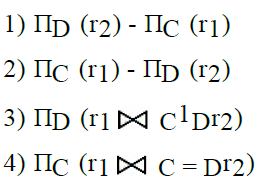Database Design(Normal Forms)
Question 11
Let r be a relation instance with schema R = (A, B, C, D). We define r1 = ΠA, B, C (r) and r2 = ΠA.D (r). Let s = r1 * r2 where * denotes natural join. Given that the decomposition of r into r1 and r2 is lossy, which one of the following is TRUE?
Question 12
Consider a relation scheme R = (A, B, C, D, E, H) on which the following functional dependencies hold: {A–>B, BC–>D, E–>C, D–>A}. What are the candidate keys of R?
Question 13
Let R1 (A, B, C) and R2 (D, E) be two relation schema, where the primary keys are shown underlined, and let C be a foreign key in R1 referring to R2. Suppose there is no violation of the above referential integrity constraint in the corresponding relation instances r1 and r2. Which one of the following relational algebra expressions would necessarily produce an empty relation ?


Question 14
The relation scheme Student Performance (name, courseNo, rollNo, grade) has the following functional dependencies:
name, courseNo → grade rollNo, courseNo → grade name → rollNo rollNo → nameThe highest normal form of this relation scheme is
Question 15
Consider the relation Student (name, sex, marks), where the primary key is shown underlined, pertaining to students in a class that has at least one boy and one girl. What does the following relational algebra expression produce? (Note: r is the rename operator).
 The condition in join is "(sex = female ^ x = male ^ marks ≤ m)"
The condition in join is "(sex = female ^ x = male ^ marks ≤ m)"
 The condition in join is "(sex = female ^ x = male ^ marks ≤ m)"
The condition in join is "(sex = female ^ x = male ^ marks ≤ m)"Question 16
Consider the following functional dependencies in a database:
Data_of_Birth → Age Age → Eligibility Name → Roll_number Roll_number → Name Course_number → Course_name Course_number → Instructor (Roll_number, Course_number) → GradeThe relation (Roll_number, Name, Date_of_birth, Age) is:
Question 17
Relation R with an associated set of functional dependencies, F is decomposed into BCNF. The redundancy (arising out of functional dependencies) in the resulting set relations is.
Question 18
With regard to the expressive power of the formal relational query languages, which of the following statements is true?
Question 19
Relation R is decomposed using a set of functional dependencies, F and relation S is decomposed using another set of functional dependencies G. One decomposition is definitely BCNF, the other is definitely 3NF, but it is not known which is which. To make a guaranteed identification, which one of the following tests should be used on the decompositions? (Assume that the closures of F and G are available).
Question 20
From the following instance of a relation scheme R (A, B, C), we can conclude that :
| A | B | C |
| 1 | 1 | 1 |
| 1 | 1 | 0 |
| 2 | 3 | 2 |
| 2 | 3 | 2 |
There are 89 questions to complete.
Last Updated :
Take a part in the ongoing discussion